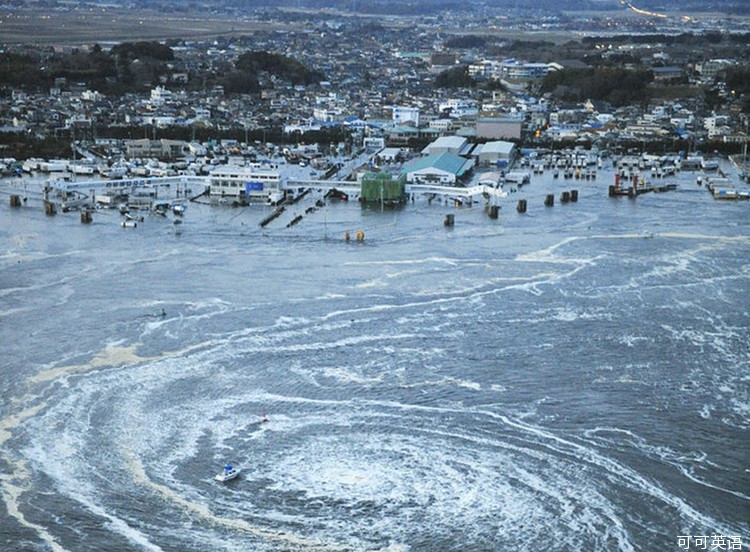
On Aug. 9, 1945, my great-uncle was out fishing in the Pacific, far enough away from Nagasaki, Japan, that he missed the immediate impact of the atomic bomb dropped by the Americans that day. My great-aunt was in their new house outside Nagasaki; the entire family had only a few days earlier fled the city because my great-uncle feared a repeat of the bombing of Hiroshima.
1945年8月9日,我的叔祖父正在太平洋上出海捕鱼,因为远离日本长崎,侥幸躲过了美国人那天投下的那颗原子弹造成的直接伤害。我的叔祖母当时正在他们位于长崎市外的新房子中。他们全家几天前才刚刚搬出长崎市区,因为我的叔祖父担心广岛的原子弹轰炸会在长崎重演。
I heard this story many times during my childhood. Back then, it made me feel that my great-uncle was a clever man. As an adult, I realized he was also very lucky, because cleverness alone cannot keep you safe.
这个故事我在儿时听过许多次。那时,每回听都让我觉得叔祖父真是太聪明了。长大后我才明白,他同时还非常幸运,因为光凭聪明并不能保你安然无恙。
For 36 hours after the earthquake and tsunami that eviscerated the east coast of Japan on March 11th, 2011, I was unable to get any word from my relatives who oversee and live in our family’s Buddhist temple in Iwaki City, south of Sendai, the biggest city near the epicenter. I wondered if they too were lucky and smart.
2011年3月11日,地震和海啸重创了日本的东海岸,之后的36小时,我一直无法与亲人们取得任何联系。他们在震中附近最大的城市——仙台南部的磐城,住在我们家族的佛寺中,看护这座佛寺。我不知道他们这次是否也同样幸运与聪明。
I wanted to know, and I did not want to know. I dipped into the world of the Internet, with its videos of water raging over the farmland and crushed ferries, and then quickly backed out. Not looking at the videos kept reality at bay, because the images of the coastline do not match the Japan that I know.
我很想知道,却又害怕知道。我上网浏览,网上的那些视频里滔天大水狂暴地吞没农田,击碎渡船,然后又迅速退却。如果不看这些视频,就无法知道现实的残忍,因为画面中出现的海岸景象与我记忆中的日本判若两个世界。
In the Japan that I know, I board the Joban Line train from Ueno station in Tokyo, and travel up the northeast coast to Iwaki City. If it’s spring, the bento stalls in the station sell cherry blossom-themed meals to eat on the train: pink cakes made of mochi rice paste are cut into flower shapes. The train will stop at Kairakuen, a park in Mito City that is famous for its plum blossoms. In the evening, the trees are illuminated from below, making neon pink froth against an indigo sky.
在我记忆中的日本,我常从东京上野车站乘坐常磐线,沿东北海岸北上,直到磐城。如果正值春季,火车站里那些卖盒饭的小摊就会提供以樱花为主题的美食——将粉色糯米团做成的糕饼都切成樱花的形状——让旅客在火车上享用。火车会在偕乐园作短暂停留,偕乐园是水户市一个以梅花著称的公园。每到晚上,公园里的树都会被它们脚下的灯光照亮,在黛蓝色夜空的映衬下,呈现出一片浮华的霓虹样的粉红。
Not long after Kairakuen, the train curves and begins to hug the coast. Then I know that I have entered Tohoku, the northern region of Japan where the goddesses and demons of legend seem to be alive and seafood is sweet.
过了偕乐园不远,火车便会转弯,开始沿着海岸蜿蜒而行。这时,我就知道已经进入日本北部地区了。传说中的女神和魔鬼们似乎还在这里生活,这儿的海鲜非常鲜美。
Often on this journey, I will switch to a local train to get off at Nakoso, a town famous for its inns and hot springs. My favorite spa, Sekinoyu, is just yards off the beach, a vegetation-thick cliff at its back. The waves of the North Pacific crash right outside the windows.
在这段旅程中,我经常会中途换乘当地的火车,然后在勿来下车。勿来是一个小镇,以旅馆和温泉而闻名。我最喜欢的“关之汤”温泉中心距海滩仅数步之遥,背靠草本繁茂的悬崖,北太平洋的海浪就在窗外恣肆喧腾。
I do not see how the spa could have survived the tsunami. Its web site is eerily still online, with numerous photos of ocean views through the windows of baths and dining rooms; no status update is posted on its main page.
我觉得那个温泉中心不可能逃过这场海啸的浩劫。但它的网站却还幽灵般地在线,那些通过浴室和餐厅的窗户拍摄的许多海景照片还在网上。但网站主页上却没有更新中心现在的状况。
The Joban train now does not run any further than Mito City; past this, the tsunami has battered train tracks and highways, making passage nearly impossible. A section of one train was found on its side just north of Iwaki City, the cars abandoned.
现在,常磐线列车走到水户市就到头了,水户往前的铁轨和公路已经被海啸摧毁,要想通行几乎是不可能的了。就在磐城北部,人们发现了一列火车的一部分车身侧躺于路旁,车厢已被废弃。
The beach where I used to play at Oarai, a town whose name means “big washing” and which sounded romantic in happier times, is covered with sludge. Sendai is home to the most famous and romantic summer festival, Tanabata, when the stars Vega and Altair, who are in love but separated by the Milky Way, are reunited for one night. Sendai, site of many happy pilgrimages for me, has also been pummeled.
我过去常常来大洗町的海滩游玩,这个镇的名字是“大清洗”的意思。在幸福的时光里,这个名字听起来何其浪漫,但现在,这里的海滩已经被淤泥覆盖了。仙台是最为著名和浪漫的一个夏季节日七夕节的故乡。在七夕这一天,被银河分隔两岸的爱侣织女和牛郎才能相会,共度一个团圆之夜。我曾多次前往仙台旅行,度过了许多美好的时光,但如今,它也在海啸中受到了严重冲击。
All this has happened even though Japan is arguably better prepared than any other country when it comes to earthquakes and other natural disasters.
应该说,相比其他国家,日本在应对地震和其他自然灾害方面准备得更加充分。但即便如此,这一切还是发生了。
When I was a child growing up in California, my Japanese mother would ask me, “How do you know a tsunami is coming?”
我在加利福尼亚长大,母亲是日本人,小时候她总是问我:“你怎么判断海啸要来了呀?”
“When the ocean starts to disappear,” I would say.
“大海开始退潮时,海啸就来了。”我说。
“And then what do you do?”
“那你该怎么办呢?”
“Drop everything and run up a hill.”
“丢下一切东西,跑到山上去。”
The residents of Fukushima Prefecture would have been taught this as well, and yet most would have had only 15 minutes to understand they had just experienced an earthquake, to notice the sea was retreating, and escape.
福岛县的人们应该也学过这些知识,但他们大多数人也只有15分钟的时间来完成所有事情:明白自己刚刚经历的是一场地震,注意到海水正在退潮,然后拔足逃命。
After 36 hours, I get through to my family at the temple in Iwaki. My relatives are unharmed, but there are new fears of a catastrophic meltdown at the Fukushima Daiichi nuclear power plant, just 30 miles away. One of the family cars is full of gas, and they assure me that they can escape at a moment’s notice. Fuel is in short supply, so in this, they are lucky.
灾难发生36个小时之后,我与磐城佛寺里的亲人们取得了联系。虽然他们都安然无恙,但是却面临着新的恐怖——离他们30英里外的福岛第一核电站可能会发生灾难性的核反应堆堆芯熔化事故。家里的一辆车已经加满了油,他们向我保证只要一听到通告便可以立刻逃离。当下燃油非常短缺,从这点来看,他们还是幸运的。
I would like them to leave right away, but they refuse to flee. The job of the keepers of a Buddhist temple, after all, is to help shepherd souls into and through the afterlife. Since they were children, my cousins have held wakes, chanted sutras over dead bodies, and anticipated the needs of those in mourning. Nuclear fallout or no nuclear fallout, their neighbors will need them.
我想让他们立即撤离,但他们拒绝这样做。毕竟,作为佛寺看护,他们的工作就是为逝者的灵魂进入并度过来世保驾护航。在我那些表亲们还小的时候,他们就开始为逝者守灵、诵经或为居丧的人们提供所需帮助。无论是否发生核泄漏,乡邻们都需要他们。
After 48 hours, the phone lines are not working again. I sit and wait.
灾难发生48小时之后,电话又打不通了。我只能静坐以待。













